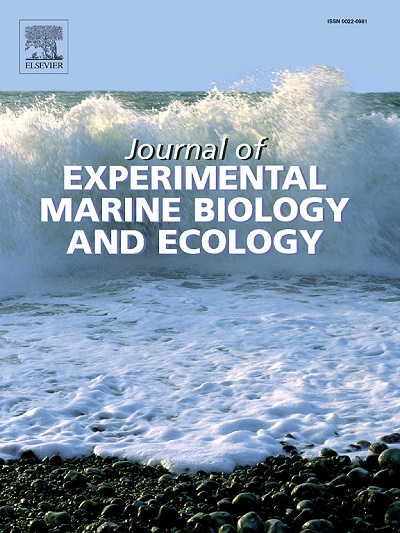Flexible foraging strategies of a tropical seabird in the western Atlantic Ocean
IF 1.8
3区 生物学
Q3 ECOLOGY
Journal of Experimental Marine Biology and Ecology
Pub Date : 2025-03-24
DOI:10.1016/j.jembe.2025.152099
引用次数: 0
Abstract
Tropical oceans are typically oligotrophic but can feature productive environments, such as islands, which can promote high prey availability, influencing predators' foraging strategies in time and space. This study investigates interannual and sex-specific variations in the foraging ecology of the masked booby (Sula dactylatra) in the Fernando de Noronha Archipelago, western tropical Atlantic Ocean. During the 2017, 2018, 2019, and 2022 breeding seasons, blood from birds and muscle samples from regurgitated prey were analyzed for stable isotopes of carbon (δ13C) and nitrogen (δ15N). Simultaneously, birds were tracked with GPS devices and their dives were recorded by pressure sensors and later predicted by deep learning tools to estimate foraging areas. Tracking data revealed foraging areas eastward of the archipelago in all years, potentially driven by the Island Mass Effect. The δ13C and δ15N values varied significantly across the four years, but isotopic niches overlapped, except in 2022. Mixing models estimated the fourwing flying fish Hirundichthys affinis as an important prey source from 2017 to 2019, shifting to false herring Harengula clupeola in 2022. Simultaneously, foraging areas were closer to the archipelago in 2022, with shorter foraging trip duration and length. Stable isotope differences between sexes were occasional, with overlapping niches and foraging areas consistent across years. These findings showcase potential predictability in foraging areas, and also their interannual variability, suggesting shifts in prey availability and distribution around the archipelago. Our results highlight the ecological plasticity of masked boobies in tropical environments and their potential as monitors of fish community dynamics.

西大西洋热带海鸟的灵活觅食策略
热带海洋通常是低营养的,但也具有生产力环境,如岛屿,可以促进高猎物可用性,影响捕食者在时间和空间上的觅食策略。本研究调查了热带大西洋西部费尔南多迪诺罗尼亚群岛蒙面鲣鸟(Sula dactylatra)觅食生态的年际变化和性别特异性变化。在2017年、2018年、2019年和2022年的繁殖季节,研究人员分析了鸟类的血液和反刍猎物的肌肉样本,以检测碳(δ13C)和氮(δ15N)的稳定同位素。同时,用GPS设备跟踪鸟类,用压力传感器记录它们的潜水情况,然后用深度学习工具进行预测,以估计觅食区域。跟踪数据显示,所有年份的觅食区域都在群岛东部,可能是由岛屿质量效应驱动的。δ13C和δ15N值在4年内变化显著,但同位素生态位重叠,除了2022年。混合模型估计,从2017年到2019年,四翼飞鱼Hirundichthys affinis是重要的猎物来源,2022年转向假鲱鱼Harengula clupeola。同时,2022年的觅食区域更靠近群岛,觅食行程时间和长度更短。性别之间稳定的同位素差异是偶然的,重叠的生态位和觅食区域多年来是一致的。这些发现显示了觅食区域的潜在可预测性,以及它们的年际变化,表明了猎物在群岛周围的可用性和分布的变化。我们的研究结果强调了热带环境中蒙面鲣鸟的生态可塑性及其作为鱼类群落动态监测的潜力。
本文章由计算机程序翻译,如有差异,请以英文原文为准。
求助全文
约1分钟内获得全文
求助全文
来源期刊
CiteScore
4.30
自引率
0.00%
发文量
98
审稿时长
14 weeks
期刊介绍:
The Journal of Experimental Marine Biology and Ecology provides a forum for experimental ecological research on marine organisms in relation to their environment. Topic areas include studies that focus on biochemistry, physiology, behavior, genetics, and ecological theory. The main emphasis of the Journal lies in hypothesis driven experimental work, both from the laboratory and the field. Natural experiments or descriptive studies that elucidate fundamental ecological processes are welcome. Submissions should have a broad ecological framework beyond the specific study organism or geographic region.
Short communications that highlight emerging issues and exciting discoveries within five printed pages will receive a rapid turnaround. Papers describing important new analytical, computational, experimental and theoretical techniques and methods are encouraged and will be highlighted as Methodological Advances. We welcome proposals for Review Papers synthesizing a specific field within marine ecology. Finally, the journal aims to publish Special Issues at regular intervals synthesizing a particular field of marine science. All printed papers undergo a peer review process before being accepted and will receive a first decision within three months.

 求助内容:
求助内容: 应助结果提醒方式:
应助结果提醒方式:


